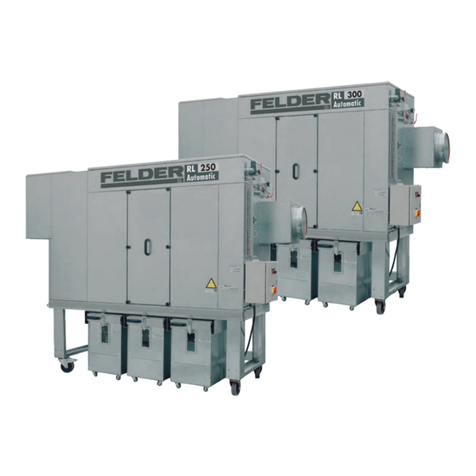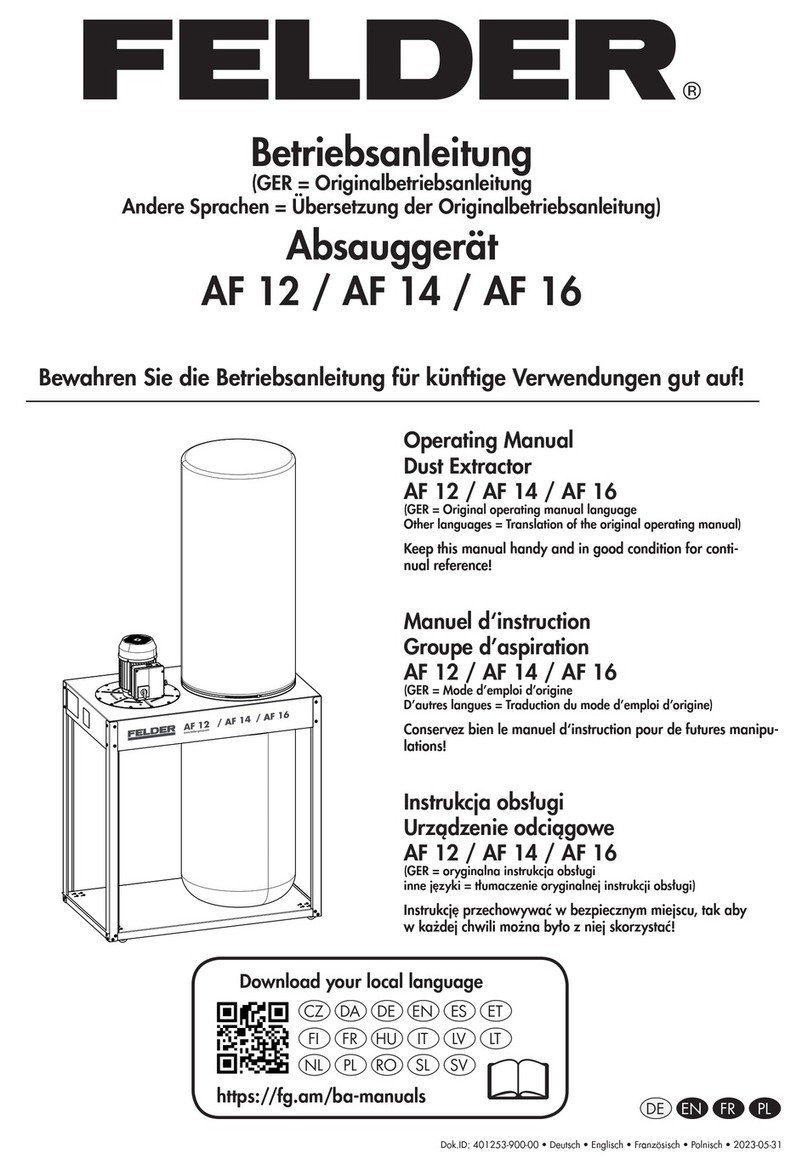Felder RL 250 User manual

User Manual
Dust Extractor
RL 250/300/350
Keep this manual handy and in good condition for continual reference!
Dok.ID: 435031-904_02 • Englisch • 2018-03-30
Translation

2
!
Dust Extractor
RL 250 / RL 300 / RL 350
© Felder KG
KR-FELDER-STR.1
A-6060 Hall in Tirol
Tel.: +43 (0) 5223 / 58 50 0
Fax: +43 (0) 5223 / 56 13 0
Email: info@felder.at
Internet: www.felder.at
FELDER A product of the FELDER GROUP
Note: Year of construction
The machine number of this machine will be printed on the cover sheet of this operating manual.
The final two digits of the machine number show the year of construction of this machine.
e.g. XXX.XX.XXX.18 -> Year of manufacture 2018
Important Notices!
Please note, that depending on the model of the machine, not all described functions are present, or
additional functions and buttons are available (e.g. machines with special functions).
For the safety of all personnel, it is necessary to study this manual thoroughly before assembly and
operation. This manual must be kept in good condition and should be considered as part of the
machine. Furthermore, the manual must be kept to hand and within the vicinity of the machine so
that it is accessible to operators when using, maintaining or repairing the machine.
Attention! Risk of material damage!
The machine must be inspected immediately upon arrival. If the machine has been damaged during
transport, or if any parts are missing, a written record of the problems must be submitted to the
forwarding agent and a damage report compiled. Also be sure to notify your supplier immediately.

3
Dust Extractor
RL 250 / RL 300 / RL 350
Contents
02 • Englisch
1 General .......................................................................................................................5
1.1 Symbol legend ...............................................................................................................5
1.2 Information about the manual ..........................................................................................5
1.3 Liability and warranty .....................................................................................................6
1.4 Copyright ......................................................................................................................6
1.5 Warranty notice .............................................................................................................6
1.6 Spare parts ...................................................................................................................6
1.7 Disposal ........................................................................................................................7
1.8 Responsibilities of the operator .........................................................................................7
1.9 Personnel requirements ....................................................................................................7
2 Safety .........................................................................................................................8
2.1 Work safety ..................................................................................................................8
2.2 Manual contents ............................................................................................................8
2.3 Making changes and modifications to the machine.............................................................8
2.4 Intended use ..................................................................................................................9
2.5 Location site requirements ................................................................................................9
2.6 Personal protective equipment ........................................................................................10
2.7 Other risks ..................................................................................................................10
2.8 Machine hazards .........................................................................................................10
2.9 Fire hazards ................................................................................................................11
2.10 Noise emission ..........................................................................................................11
2.11 Safety cover ..............................................................................................................11
2.12 Procedure in case of fire (Emergencies) .........................................................................12
2.13 Explosion pressure proofness .......................................................................................12
3 Declaration of Conformity ..........................................................................................13
4 Technical specifications...............................................................................................14
4.1 Dimensions and weight .................................................................................................14
4.1.2 Important information ..............................................................................................14
4.2 Performance diagram ...................................................................................................15
4.3 Data plate ...................................................................................................................16
4.4 Noise emission ............................................................................................................16
5 Transport, packaging and storage ..............................................................................18
5.1 Safety instructions ........................................................................................................18
5.2 Transport .....................................................................................................................18
5.3 Transport inspection ......................................................................................................18
5.4 Packaging ...................................................................................................................19
5.5 Storage .......................................................................................................................19
Table of contents

4
Dust Extractor
RL 250 / RL 300 / RL 350
6 Setup and installation ................................................................................................20
6.1 Safety instructions ........................................................................................................20
6.1.1 Setup .....................................................................................................................20
6.2 Assembly ....................................................................................................................21
6.2.1 Basic extractor ........................................................................................................21
6.2.2 Chip container (Standardaus equipment) ....................................................................22
6.2.3 Mirror-inverted operation ..........................................................................................22
6.2.4 Collector casters (Optional equipment: Rotary feeder) ..................................................23
6.2.5 Vacuum connector assembly .....................................................................................23
6.3 Fire prevention and extinguisher .....................................................................................24
6.3.1 Fire extinguisher: Water ...........................................................................................24
6.3.2 Fire extinguisher: Extinguisher ...................................................................................25
6.4 Floor space requirement ................................................................................................25
6.5 Electrical connection .....................................................................................................26
6.5.1 Potential-free contact ................................................................................................27
6.5.2 Automatic Starting Device ........................................................................................28
6.6 Connect the compressed air supply ................................................................................28
6.7 Dust extractor operation ................................................................................................29
7 Operation .................................................................................................................30
7.1 Safety instructions ........................................................................................................30
7.2 Inserting/replacing the chip bags ...................................................................................31
7.4 Electrics ......................................................................................................................32
7.4.1 Dedusting the filter ..................................................................................................33
7.4.2 Electrics - Optional equipment: Rotary feeder ..............................................................34
7.4.3 Monitoring the dirt accumulation on the filter ..............................................................35
8 Service ......................................................................................................................36
8.1 Safety instructions ........................................................................................................36
8.2 Maintenance schedule ..................................................................................................36
8.3 Motor and electrical equipment ......................................................................................37
8.4 Dust collector / Seals ....................................................................................................37
8.5 Fire extinguisher: Extinguisher / Water ...........................................................................37
8.6 Extinguisher: Maintenance and servicing (Every two years) ...............................................38
8.7 Safety cover (Check every six months) ............................................................................38
8.8 Empty the condensation receptable ................................................................................40
8.9 Changing the filter .......................................................................................................41
8.10 Dust hazard prevention ...............................................................................................42
8.10.1 Removing the collected materials .............................................................................42
8.11 Faults, causes and repairs ...........................................................................................43
9 Annual general revision inspection certificate ..............................................................44
Table of contents

5
!
Dust Extractor
RL 250 / RL 300 / RL 350
1 General
1.1 Symbol legend
1.2 Information about the manual
This manual describes how to operate the machine
properly and safely. Be sure to follow the safety tips and
instructions stated here as well as any local accident
prevention regulations and general safety regulations.
Before beginning any work on the machine, ensure that
the manual, in particular the chapter entitled “Safety”
and the respective safety guidelines, has been read in its
entirety and fully understood. This manual is an integral
part of the machine and must therefore be kept in the
direct vicinity of the machine and be accessible at all
times. If the machine is sold, rented, lent or otherwise
transferred to another party, the manual must accompany
the machine.
General
Important technical safety instructions in this manual are
marked with symbols.
These instructions for work safety must be followed.
In all these particular cases, special attention must be
paid in order to avoid accidents, injury to persons or
material damage.
Attention! Risk of material damage!
This symbol marks instructions which, if not observed, may lead to material damage, functional failures and/
or machine breakdown!
Warning! Risk of injury or death!
This symbol marks instructions that must be followed in order to avoid harm to one‘s health, injuries, perma-
nent impairment or death!
Warning! Danger! Electric current!
This symbol warns of potentially dangerous situations relating to electric current. Not observing the safety
instructions increases the risk of serious injury or death. All electrical repairs must be carried out by a qualified
electrician!
Note:
This symbol marks tips and information which should be observed to ensure efficient and failure-free operati-
on of the machine.
Other manuals for RL 250
1
This manual suits for next models
2
Table of contents
Other Felder Vacuum Cleaner manuals






















